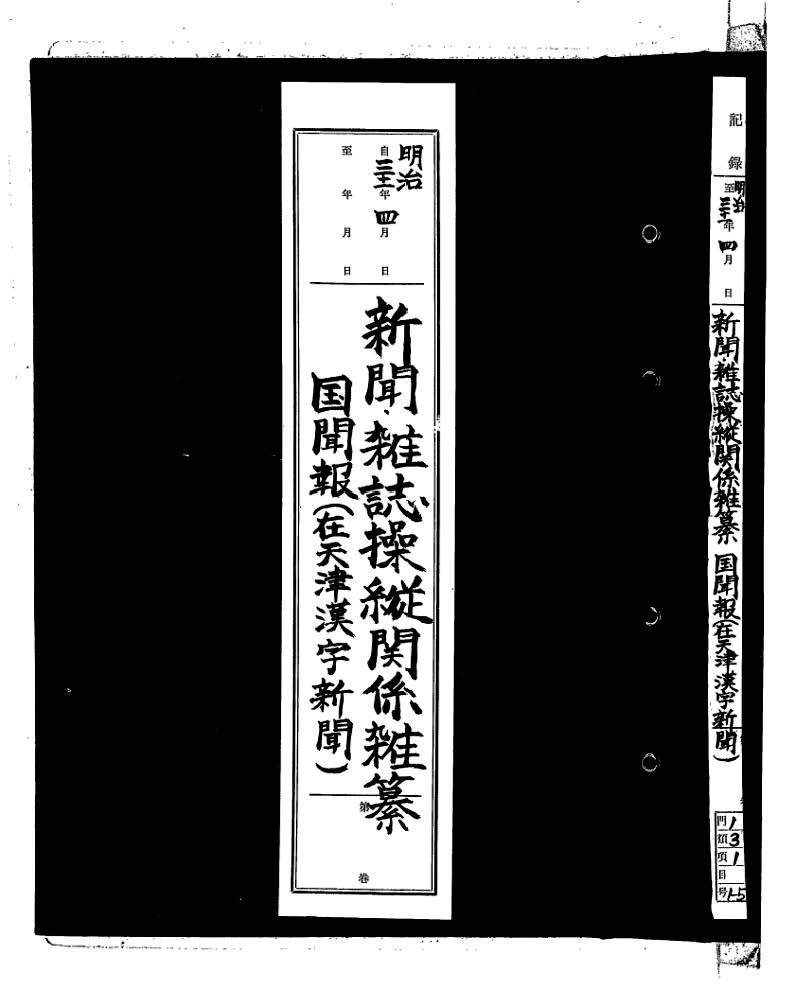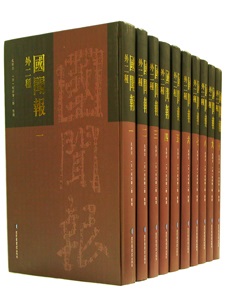JACAR Newsletter
JACAR Newsletter Number 34
March 31, 2021
Contents
Special Feature : Encountering JACAR
Special Feature : Encountering JACAR
This year, the Japan Center for Asian Historical Resources (JACAR) celebrates its 20th anniversary. My connection with JACAR goes back to 2003, so you might say I’m an already old-timer among the users of its services.Back in 1999, while I was in the United States doing research, I was approached by my old friend Kong Xiangji—a Chinese scholar who is globally renowned as a student of the Hundred Days’ Reform movement—about carrying out a joint research project. In the modern era, Japan had become a destination for Chinese exiles and students studying abroad. As a result, it has an abundance of unpublished and unused records about the activities of this overseas Chinese population. Kong proposed to me that we should look into comparing these materials with those available in China as a way to deepen research on the history of Sino-Japanese relations.
I readily endorsed the idea. I extended an invitation for Kong to take up a lengthy stay at the University of Tokyo as a visiting professor and hold seminars for graduate students. This was in 2003. Once Kong had checked into his housing at the university’s Shirokanedai Lodge for international visiting scholars, the first place I took him to was the Diplomatic Archives of the Ministry of Foreign Affairs. During his yearlong stay in Tokyo, Kong visited the Archives practically every single day it was open. It was right around this time when JACAR fully launched its digital collection. By pure chance, I happened to have a connection with JACAR through a former pupil of mine who was working there part-time. And so, that May or June with a dozen or so of my then-current students in tow, I made my way to the office building in Tokyo’s Hirakawa-chō where JACAR was (and still is) located.
We were greeted by JACAR’s senior researcher, the late Muta Shōhei. He was very welcoming to us, and he kindly explained about how JACAR came to be, what kind of work it did, and its plans for digitalization. (I think the second time we visited, we were shown images from part of the Hull Note while receiving a mini-lecture on the road to war between Japan and the United States.) He also mixed in an interesting tidbit about the letters “MT” that were stamped on diplomatic papers from the Meiji and Taishō periods. Sometimes these letters were stamped upside down, and it seemed that this was due to some official involved with the postwar Occupation who was unfamiliar with Japanese and didn’t know which was the top and which was the bottom of a given document.
Mr. Muta spoke of how JACAR planned to make openly available to the public records related to diplomacy, politics, and military matters from the history of modern Japan regardless of any negatives therein. His attitude left a strong impression on Kong and the students from overseas. (Bu Ping, the late director of the Institute of Modern History at the Chinese Academy of Social Sciences who also served as co-chair for the Chinese side on the Japan-China Joint History Research Committee, mentioned directly to me that he had been left with the same impression.) Given the powerful educational effects this had on the students, even after Professor Kong went back the following year to the United States I brought my students along to listen to what Mr. Muta had to say. Sadly, this would be the last time I met him.
In any case, the joint research project with Professor Kong proceeded even better than we had expected. It resulted in two collections of articles in Chinese (""罕為人知的中日結盟及其他: 清末中日関係史新探" and "従東瀛皇居到紫禁城: 晩清中日関係史上的重要人物与事件") and one in Japanese ("清末中国と日本: 宮廷・変法・革命"). Many other works also resulted, but all were made possible by the gifts of MOFA's Diplomatic Archives and JACAR.
Of these projects, one that I particularly wish to make note of was the discovery in our review of diplomatic correspondence from the Meiji era of bound copies of "Shinbun zasshi sōjū kankei zassan/Guowen Bao" (Reference numbers: B03040605800, B03040605900, and B03040606000). Guowen Bao was an influential daily newspaper published in Tianjin, and our finding allowed us to conduct in-depth research on it. Guowen Bao had been bought up at the end of the 19th century in an effort by Japan to manipulate public opinion (propaganda warfare) in China. However, even in China there are no materials to enlighten us about the backstage workings of the daily's operations, so our research attracted considerable attention from the Chinese scholarly community. Happily for us, this provided Professor Kong and I with the chance to publish in China a facsimile edition of the newspaper that also included a lengthy commentary by ourselves as well as complete-text versions of the relevant Foreign Ministry correspondence (Kong Xiangji and Murata Yūjirō, "国聞報(外二種)". Ten volumes. Beijing: National Library of China, 2013.) There were a variety of difficulties that arose from communicating with the publisher and with Professor Kong via email when it came to getting the volumes published, and owing to circumstances in China the actual publication was also quite delayed. However, it was truly helpful for us that, thanks to JACAR, images of all the bound volumes were all already available in digital form. For me, this was certainly my first experience of really getting sense of just how valuable digital archives can be for doing historical research.
When Professor Kong and I started issuing our first reports on our joint research, funding from Chinese universities became quite abundant, and our opportunities to hold intensive seminars and deliver lectures increased dramatically. Whenever I talk about research on the history of relations between Japan and China in modern times, I make it a regular point to talk about the materials available through JACAR that Kong and I uncovered in our joint research project. It is also my established practice wherever I go to use as a lead-in for my comments to talk about how JACAR came to established as part of the Murayama Tomoichi-led government's Peace, Friendship, and Exchange initiative.
Frankly speaking, it is quite exhausting mentally to talk about the history of Sino-Japanese in the modern era in front of Chinese students and people generally. This is because as a citizen of the nation that was the aggressor you cannot help but find yourself put on the defensive morally. In interactions with China, just as Mr. Muta remarked in his comments to me, for me at least the very existence of JACAR has been useful in how it has revised my sense that the moral imbalance is being righted even if only a little bit. I do not know what it's like for other people. If nothing else, for me JACAR is like to be become an even more important "venue" in the effort to encourage meetings of minds with neighboring countries.
Also, at my previous institution I sometimes held lectures for students about JACAR. Due to the coronavirus calamity, it was not possible last year to hold such talks at my current institution Doshisha University. However, in the autumn I did offer an online lecture also open to students from other institutions that saw more than 30 participants from undergraduates to doctoral students. For many of the students from foreign countries, this was the first time they had even heard about JACAR, a state of affairs that made me keenly aware of the need to further make this resource better known.
Yūjirō Murata, Dōshisha University



